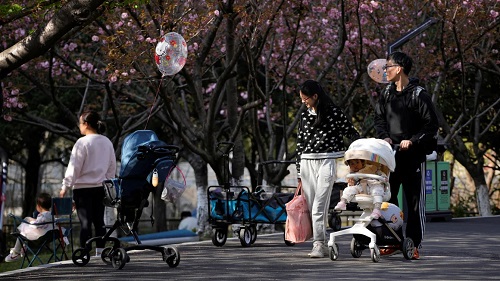
China’s population declines for second straight year as economy stumbles
China reported a record low birth rate in 2023 as its population shrank for the second year in a row. The trend marked the deepening of a demographic challenge set to have significant implications on the world’s second largest economy.
Advertisement
The country recorded 6.39 births per 1,000 people, down from 6.77 a year earlier, China’s National Bureau of Statistics (NBS) announced Wednesday. The birth rate is the lowest since the founding of Communist China in 1949.
Some 9.02 million babies were born, compared with 9.56 million babies in 2022. The overall population fell in 2023 to 1.409 billion, down 2.08 million people from the previous year, the bureau said.
“To be sure, last year’s sharp decline should be partly due to the lockdowns and most likely new births will rebound in 2024, although the structural down-trend remains unchanged,” said Larry Hu, chief China economist for Macquarie Group.
The country’s demographic shift comes at a time when its growth is sputtering. The NBS confirmed that China’s economy grew by 5.2% last year, compared to a government target of around 5%.
While this expansion marks a significant pick-up over 2022, when China’s economy grew by just 3%, it is still one of the country’s worst economic performances in over three decades.
Chinese stocks tumbled on Wednesday following the data release. Hong Kong’s Hang Seng Index sank 4.1% by mid-afternoon, heading towards its lowest closing level since October 2022. The CSI300, which consists of 300 major stocks listed in Shanghai and Shenzhen, fell 2.2%. Both indexes had a dismal year in 2023, down more than 10% each.
China has been beset by a series of economic problems, including investor exodus and deflation. The shrinking population will now force Beijing to make some structural changes in its economy and reshape sectors including healthcare and housing.
Wednesday’s data wasn’t entirely gloomy. In the fourth quarter, China’s GDP expanded 5.2%, accelerating from the third quarter’s 4.9% growth. However, this boost may not be long-term, experts said.
“There are two key drivers behind this: the unexpected, but short-lived release of pent-up demand during the [third quarter] holidays, and the low base effect of [fourth quarter] 2022,” said Alfredo Montufar-Helu, head of the China Center for Economics and Business at the Conference Board.
He believes China’s GDP growth will decelerate to 4.1% in 2024 because of several significant headwinds to growth, including the ongoing property downturn and subdued consumption.
In December, new home prices fell by the highest amount in nearly nine years, according to a Reuters calculation based on NBS data, and property investment slumped 9.6% in 2023 from the previous year, marking a second straight year of declines.
The latest figures come after China’s population declined for the first time in decades in 2022 in what analysts said was the country’s first drop since the 1961 famine triggered by former leader Mao Zedong’s Great Leap Forward. Last year, China was surpassed by India as the world’s most populous country.
The slowing birth rate comes despite a push from the government to encourage more married couples to have children following decades of restrictive birth policies.
“There are fewer people getting married and fewer couples want to have children,” said Yanzhong Huang, a senior fellow for global health at the Council on Foreign Relations (CFR) in New York.
The Covid-19 pandemic also likely affected the existing trend “because of (its) impact on the economy – the economic slowdown, the high unemployment rate among young people – all of that has discouraged people to get married and have kids,” he said.
The falling birth rate coincides with a shrinking workforce and a rapidly aging population: twin challenges for China’s government as it grapples with funding healthcare and pensions for elderly citizens, while aiming to maintain growth in an economy manned by fewer people of working age.
The ‘silver economy’
China’s working population, classified as those between the ages of 16 and 59, declined by 10.75 million last year, adding to an ongoing contraction. The population of those over 60, meanwhile, continued to expand. More than one-fifth of the population, or nearly 297 million people, are now in that age bracket.
China’s top administrative body, the State Council, last week released guidelines to strengthen the so-called “silver economy,” as part of top-down efforts to tackle the challenges of caring for a growing number of elderly.
The guidelines call on companies across sectors including housing, healthcare and finance to tailor services and products for the elderly. Land development and local government financing should support facilities for aging residents, it added.
The call to grow the “silver economy” follows protests in at least four cities last year, where thousands of elderly took to the streets to protest cuts to monthly medical benefits made as local government grappled with deficits.
China’s death rate and number of fatalities also rose in 2023 compared with the previous year, according to data released Wednesday. Authorities reported a death rate of 7.87 per thousand people and 11.1 million deaths. In 2022, there were 10.41 million deaths with a death rate of 7.37 per thousand.
Last year, China experienced a major outbreak of Covid-19, with infections sweeping across the country starting in late 2022 following the abrupt relaxation of stringent pandemic controls. Experts say China has not released comprehensive data on fatalities, even as authorities have defended their Covid-19 data transparency.
The increase of 690,000 deaths last year compared with 2022 is “noteworthy” when contrasted with smaller, incremental rises during pre-pandemic years, according to CFR’s Huang.
The comparison highlights a marked escalation in fatalities during the Covid era, he said. However, the latest data “might not fully capture the actual number of Covid-related deaths,” he added, pointing to how the total increase in deaths between this year and last falls short of scientific estimates of fatalities during China’s re-opening.




